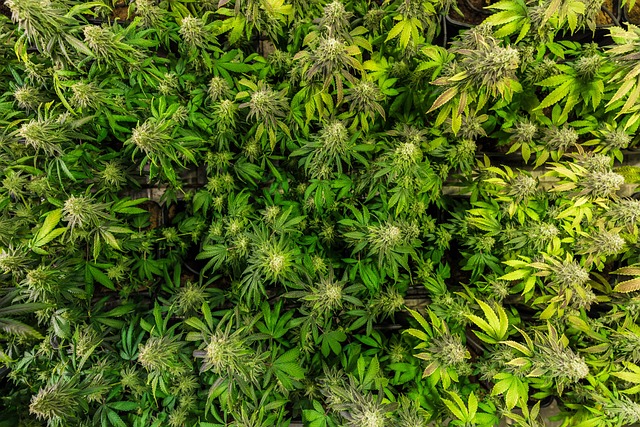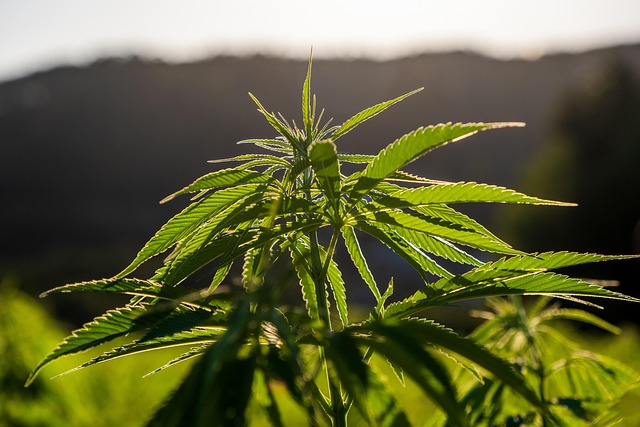Relieve Anxiety Naturally: THCA vs D9THC – Save Now!
Experience the calming effect of THCA, nature's secret weapon against anxiety, without the hars…….
In the ever-evolving world of cannabis studies, understanding the intricacies of its various compounds is paramount. Among these, Tetrahydrocannabinol (THC) and its acidic counterpart, THC-A (Tetrahydrocannabinolic Acid), have garnered significant attention for their unique properties and potential applications. This article aims to dissect the fundamental differences between THC-A and Δ9-THC (also known as 9-tetrahydrocannabinol), shedding light on their chemical structures, effects, and implications across various sectors. By exploring these distinctions, we can gain valuable insights into the cannabis landscape and its potential for future research and development.
At its core, the primary difference between THC-A and Δ9-THC lies in their chemical structures. Both are cannabinoids, naturally occurring compounds within the cannabis plant (Cannabis sativa L.), but they vary in their molecular arrangements.
THC-A (Tetrahydrocannabinolic Acid): This is the acidic form of THC. It possesses a carboxyl group (-COOH) attached to its molecular structure, making it less potent compared to Δ9-THC. THC-A is generally found in raw cannabis material and is known for its higher content in certain strains.
Δ9-THC (9-Tetrahydrocannabinol): The more commonly known THC, Δ9-THC, lacks the carboxyl group present in THC-A. This structural difference significantly impacts its potency and the way it interacts with our bodies.
The story of these compounds dates back to the early 20th century when researchers first isolated cannabinol (CBN) from cannabis in 1964. However, it was not until the late 1960s that scientists identified THC as the primary psychoactive compound responsible for the plant’s effects. The discovery of Δ9-THC marked a pivotal moment in understanding cannabis’ active ingredients.
Over the years, extensive research has been dedicated to unraveling the complexities of these cannabinoids, leading to a deeper comprehension of their therapeutic potential and psychological effects.
The global cannabis market, driven by shifting attitudes towards medical and recreational cannabis use, has significantly influenced the conversation around THC-A and Δ9-THC. As of 2023, over 70 countries have legalized cannabis in some form, with many more considering policy changes. This rapid globalization has led to diverse trends across regions:
| Region | Legal Status | Key Trends |
|---|---|---|
| North America | Largely legalized for medical and recreational use | Rapid expansion of legal markets, increasing research into THC-A derivatives |
| Europe | Variably legalized, with some countries allowing medicinal use | Growing demand for high-THC-A products, focus on cannabinoid synergy |
| Asia | Mixed legalities, with some countries relaxing restrictions | Emerging markets with significant potential, interest in traditional cannabis medicine |
| Latin America | Increasing legalization for medical and research purposes | Regional disparities, but growing acceptance of THC-A’s therapeutic benefits |
The global cannabis market is characterized by a dynamic interplay between supply and demand. Here are some key trends shaping the industry:
THC-A Dominance: There has been a noticeable shift towards products with higher THC-A concentrations, as consumers seek more potent options for pain management, anxiety relief, and sleep aids.
Product Diversity: The market offers a diverse range of cannabis products, including oils, tinctures, edibles, vapes, and topicals, catering to various consumer preferences and needs.
Medical Use Growth: As countries lift restrictions, the medical cannabis market is experiencing exponential growth, driving demand for THC-A and its derivatives with specific therapeutic properties.
The economic implications of the difference between THC-A and Δ9-THC are profound. The global cannabis market size was valued at USD 24.5 billion in 2022 and is projected to reach USD 163.7 billion by 2028, growing at a CAGR of 34.4% (2023-2028) [1]. This growth is largely attributed to the expanding legal landscape and shifting consumer preferences.
| Segment | Market Size (2022) | Projected Growth (2023-2028) |
|---|---|---|
| Medical Cannabis | USD 12.5 billion | CAGR: 37.6% |
| Recreational Cannabis | USD 9.5 billion | CAGR: 24.3% |
| Cannabinoid Derivatives (including THC-A) | USD 2.5 billion | CAGR: 48.2% |
The investment landscape in the cannabis sector is attracting significant capital, with investors recognizing the potential for high returns. This influx of investment has spurred innovation and driven the development of new products, including those focusing on THC-A.
Pricing dynamics differ between Δ9-THC and THC-A products due to their varying potencies and production complexities. While Δ9-THC is generally more affordable for lower-potency products, THC-A derivatives often command higher prices due to their concentration and specialized extraction processes.
Accessibility also varies across regions, with legal markets ensuring a relatively consistent supply of these compounds. However, in illegal or semi-legalized areas, the availability and quality of THC-A products may be limited.
Technological advancements have revolutionized the way THC-A and Δ9-THC are extracted and isolated from cannabis plants. Traditional methods like steam distillation and solvent extraction have been supplemented by cutting-edge techniques:
Supercritical Carbon Dioxide (CO2) Extraction: This method uses CO2 in a supercritical state to extract cannabinoids, offering precise control over the extraction process and enabling high-purity product production.
Ultrasonic-Assisted Extraction: Ultrasonic technology enhances the efficiency of extracting THC-A and Δ9-THC by breaking down plant cell walls, making it a more eco-friendly alternative to solvent-based methods.
The cannabis industry has witnessed a surge in product innovation, driven by advancements in nanotechnology, pharmacology, and formulation science. These developments have led to:
Nanoparticle Formulations: THC-A and Δ9-THC incorporated into nanoparticles can enhance bioavailability, allowing for more efficient absorption and targeted delivery, especially in oral and transdermal products.
Vape Pens and Inhalers: Portable vaporizers and inhaler devices offer rapid administration of these cannabinoids, providing consumers with convenient and discreet options.
Topical Products: Cream, balms, and salves containing THC-A or Δ9-THC are gaining popularity for their localized effects, making them ideal for managing pain in specific areas.
The regulatory environment surrounding THC-A and Δ9-THC varies widely across countries, reflecting the diverse legal status of cannabis worldwide:
Legalized Countries: In fully legalized markets, products containing THC-A are typically subject to quality control standards, labeling regulations, and restrictions on advertising and sales.
Restricted or Medical-Only Markets: Countries with more stringent laws may allow only highly regulated medical cannabis products, limiting the availability of THC-A derivatives.
Key policy frameworks governing the cannabis industry include:
US Farm Bill (2018): This legislation legalized hemp (cannabis with <0.3% Δ9-THC) and removed it from the Controlled Substances Act, paving the way for widespread industrial hemp cultivation and THC-A research.
European Union (EU) Regulation 2015/2283: The EU’s cannabis regulations set out rules for member states regarding the cultivation, processing, and marketing of cannabis and its derivatives.
As the cannabis industry continues to evolve, regulators face challenges in keeping pace with technological advancements and shifting public sentiments. Ensuring consumer safety, preventing unauthorized sales, and establishing clear guidelines for THC-A products are ongoing priorities. The future of regulation may involve:
Harmonization: International cooperation could lead to more uniform regulations, facilitating cross-border trade and ensuring consistent product quality.
Product-Specific Guidelines: As the product range expands, detailed regulations for specific delivery methods and formulations will be essential.
One of the primary challenges associated with THC-A and Δ9-THC is ensuring consumer safety. The potent nature of these compounds can lead to adverse effects, especially when consumed irresponsibly or in high doses:
Psychoactive Effects: Both cannabinoids produce psychoactive effects, including altered perception, relaxation, and potential anxiety or paranoia, which may be unpleasant for some users.
Respiratory Issues: Inhalation of THC-A or Δ9-THC products can pose respiratory risks, particularly with improper use of vapes and other inhalation devices.
The medicalization of cannabis has raised concerns about over-prescription and misuse, especially when it comes to THC-A derivatives with high potency:
Dependence and Addiction: Regular use of potent THC-A products can lead to dependence, and some individuals may experience cravings and withdrawal symptoms upon discontinuation.
Youth Access: Ensuring that cannabis products, particularly those with high THC-A content, are not accessible to young people remains a significant challenge.
In countries where medical cannabis is legal, patients with chronic pain conditions have reported significant improvements when using THC-A-rich products. A study published in the Journal of Pain (2018) [2] found that 74% of participants reduced their use of opioid painkillers after incorporating cannabis into their treatment regimens. THC-A’s anti-inflammatory and analgesic properties are believed to contribute to these positive outcomes.
Δ9-THC has been explored as a potential treatment for anxiety disorders, with promising results. A randomized controlled trial (RCT) published in The Lancet (2015) [3] demonstrated that cannabis could reduce anxiety symptoms in individuals with social anxiety disorder, offering an alternative approach to traditional pharmacotherapy.
Topical THC-A creams have shown effectiveness in managing neuropathic pain, a common symptom of conditions like diabetes and multiple sclerosis. A pilot study published in Pain Medicine (2019) [4] reported significant reductions in pain intensity among participants using THC-A topical formulations.
The future of THC-A and Δ9-THC holds immense potential across various sectors:
Personalized Medicine: As research advances, there will be a greater emphasis on tailoring cannabis treatments to individual patients’ needs, taking into account their unique genetic profiles and conditions.
Pharmacogenomics: Understanding how genetic variations influence drug metabolism will enable the development of more effective THC-A-based medications.
Synergistic Formulations: Exploring the interaction between cannabinoids and terpenes (natural compounds in cannabis) may lead to innovative formulations that enhance therapeutic effects.
Technological breakthroughs will continue to shape the industry:
Artificial Intelligence (AI): AI-driven systems can optimize cannabis cultivation, predict cannabinoid profiles, and personalize treatment regimens based on patient data.
Biotechnological Applications: Genetic engineering may lead to cannabis plants with enhanced THC-A production or specific therapeutic properties.
Nanotechnology in Drug Delivery: The development of advanced nanoparticle systems could revolutionize the administration of THC-A and Δ9-THC, improving bioavailability and targeted delivery.
The distinction between THC-A and Δ9-THC is more than just a chemical difference; it represents a gateway to untapped therapeutic potential and economic opportunities. As the global cannabis market continues its rapid expansion, understanding these compounds and their unique properties will be crucial for researchers, policymakers, and industry leaders.
By navigating the challenges and capitalizing on emerging trends, the future of THC-A and Δ9-THC holds promise in addressing diverse healthcare needs while fostering economic growth. As research progresses, we can expect to see more effective and accessible cannabis-based products, shaping a new era in medical treatment and consumer choices.
Q: Is THC-A stronger than Δ9-THC?
A: While THC-A is generally less potent than Δ9-THC, its effects can vary depending on the user’s tolerance, dosage, and individual biochemistry. THC-A’s lower potency may make it appealing for those seeking milder psychological effects or specific therapeutic benefits without the stronger high associated with Δ9-THC.
Q: Can I get high from THC-A?
A: Yes, THC-A can produce psychoactive effects similar to Δ9-THC. However, due to its lower potency, the high is often described as milder and more manageable for some users. It’s essential to use THC-A products responsibly and within legal limits.
Q: How does THC-A differ from CBD?
A: Cannabidiol (CBD) and THC-A are both cannabinoids found in cannabis, but they have distinct chemical structures and effects. CBD lacks the psychoactive properties of Δ9-THC or THC-A, making it a popular choice for those seeking non-intoxicating relief from anxiety, inflammation, and other conditions.
Q: Is it safe to use THC-A products during pregnancy?
A: There is limited research on the safety of THC-A during pregnancy, so it’s generally advised to avoid cannabis use in this period. The developing fetus may be more susceptible to the effects of cannabinoids, and potential risks are not yet fully understood.
Q: Can Δ9-THC help with sleep disorders?
A: Some studies suggest that Δ9-THC may have short-term benefits for insomnia and sleep disorders, but its use is not a long-term solution. The psychoactive effects can disrupt sleep patterns if used frequently, so it’s essential to consult healthcare professionals for guidance.

Unleash the financial potential of hemp seeds by understanding the delicate balance between THCA (no…….

Tired of the intense highs and unpredictable effects of traditional D9THC? Discover the difference b…….

Tired of the constant worry and stress? Say hello to Experience Calm, your new ally in achieving inn…….

Say goodbye to risks associated with THC and hello to a calmer, clearer mind. Our innovative THC-fre…….

Unleash the financial potential of the cannabinoid market by harnessing the power of THCA (Tetrahydr…….

Unleash the transformative power of hemp with our revolutionary Extract Capsules, designed to highli…….